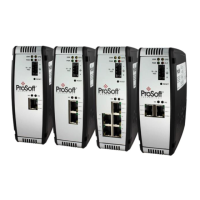ASCII Protocol PLX3x Series ♦ Multi-Protocol Gateways
User Manual
Page 144 of 215 ProSoft Technology, Inc.
January 25, 2018
Specifies the receive termination characteristics for the port. This value is
bit mapped as follows:
Bit 0 - Termination character(s) used
Bit1- Message timeout used
Bit2 - Intercharacter delay timeout used
Bit3 - Packet size limit used. If the parameter is set to zero, the port is
placed in stream mode.
Specifies the number of termination characters used to define the end of
received message if bit 0 of the Type parameter is set.
This array of 12 characters specifies the termination characters at the end
of each received message. Each character occupies one position in the
array. The number of characters to be used in the array is set in the Rx
Term Count parameter.
Specifies the length of data required to be received on the port before
transferring the data to the processor if bit 3 is set in the RX Termination
Type parameter.
Specifies the number of milliseconds to wait after the first character is
received on the port before automatically sending the data to the processor
if bit 1 is set in the RX Termination Type parameter.
Specifies the number of milliseconds to wait between each character
received on the port before sending the data to the processor if bit 2 is set
in the RX Termination Type parameter.
Specifies if the data received by the module has the byte order of the data
swapped.
NO - no byte swapping occurs.
YES - the odd byte is swapped with the even byte in each word of data
received.
Specifies the timeout period to transmit a message out the port. A
message must be transmitted out the port within the specified timeout
period. Message transmission is aborted if the timeout is exceeded.
Specifies the minimum number of milliseconds to delay before transmitting
a message out the port. This pre-send delay is applied before the RTS on
time. This may be required when communicating with slow devices.
Specifies if the data to be transmitted by the module has the byte order of
the data swapped.
NO - no byte swapping occurs.
YES - the odd byte is swapped with the even byte in each word of data
received.

